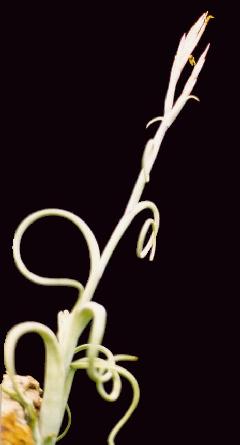
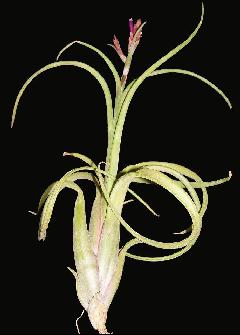
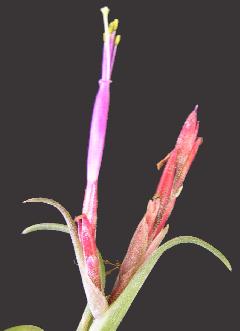

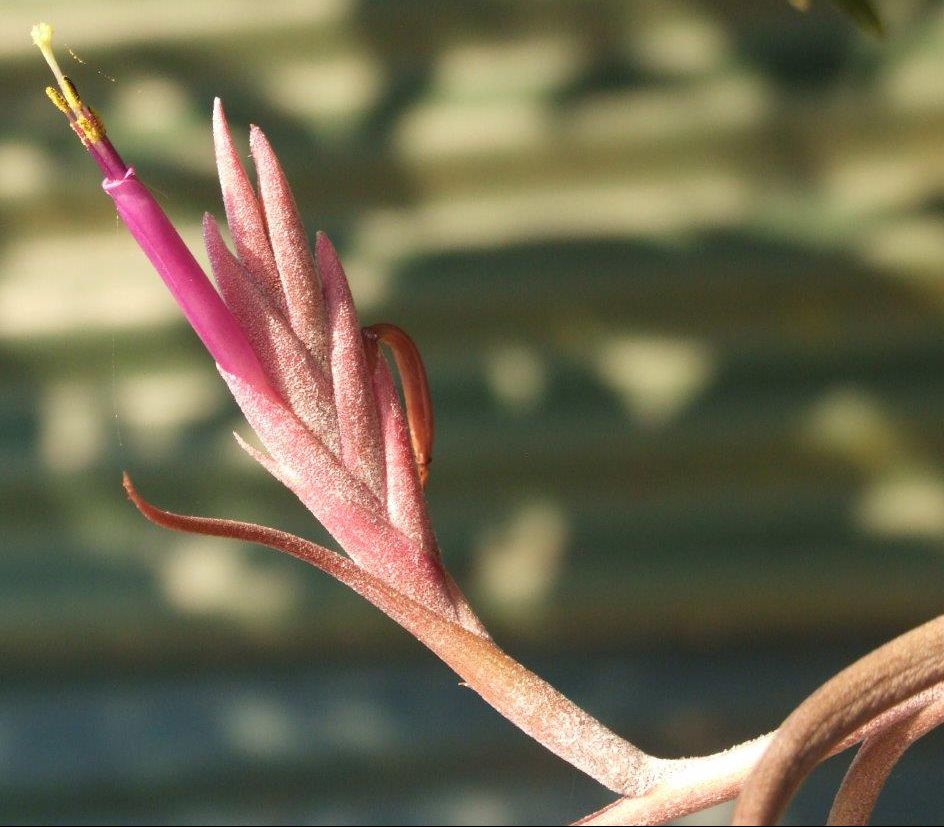

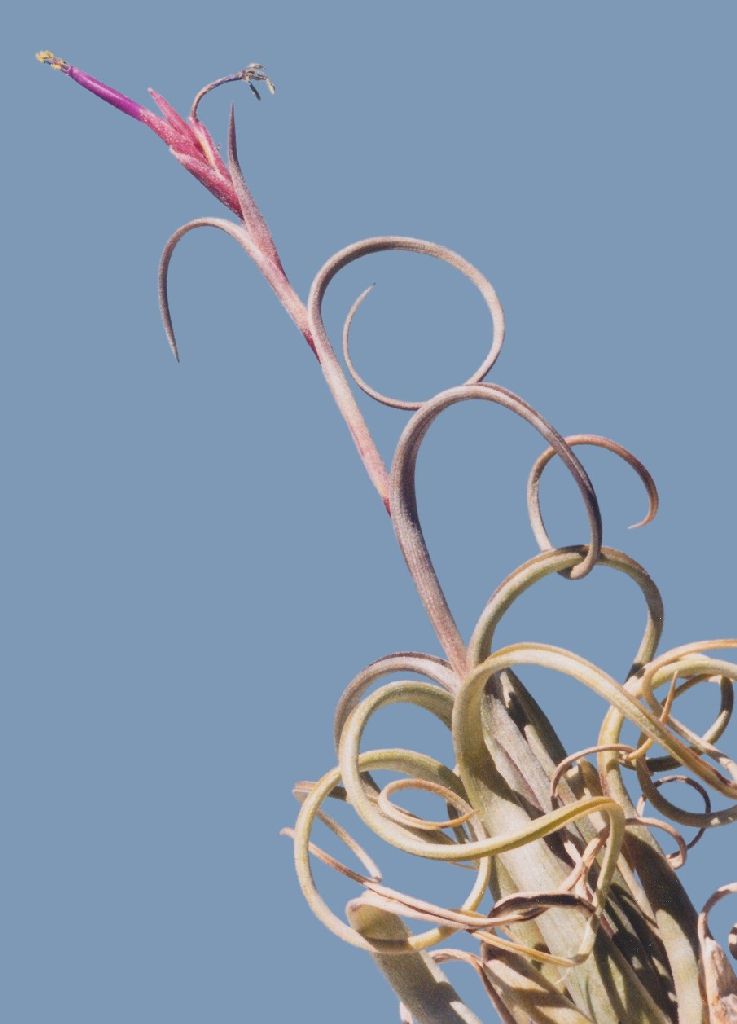
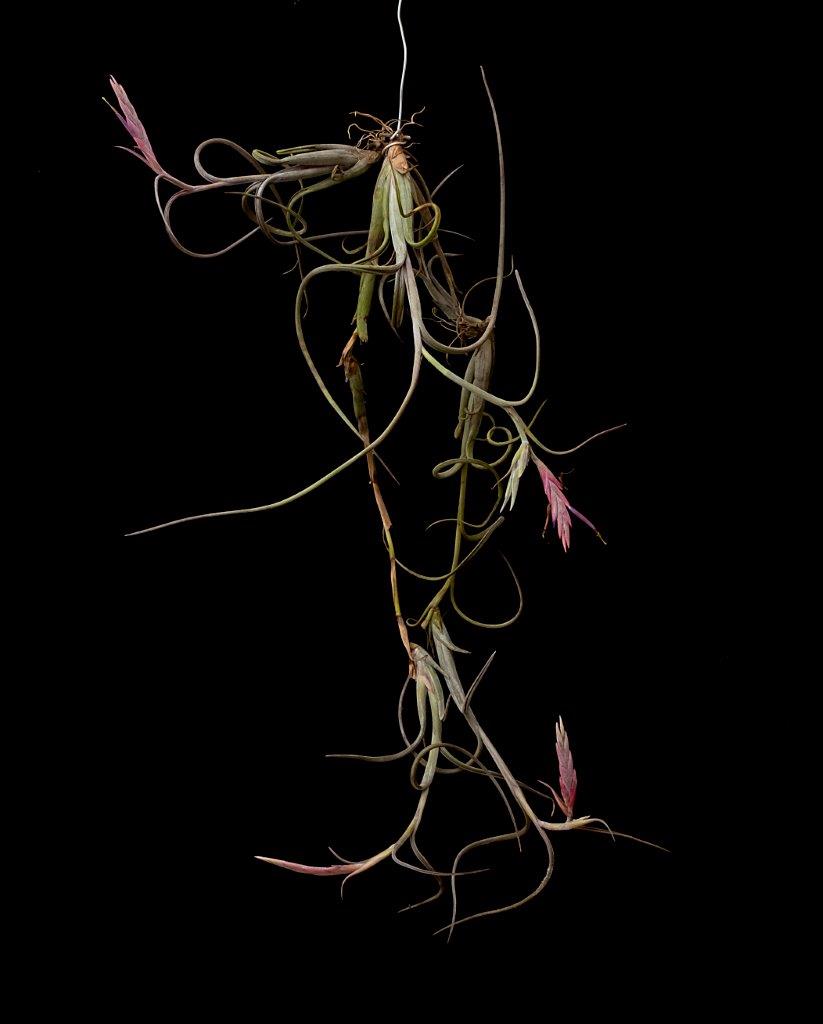
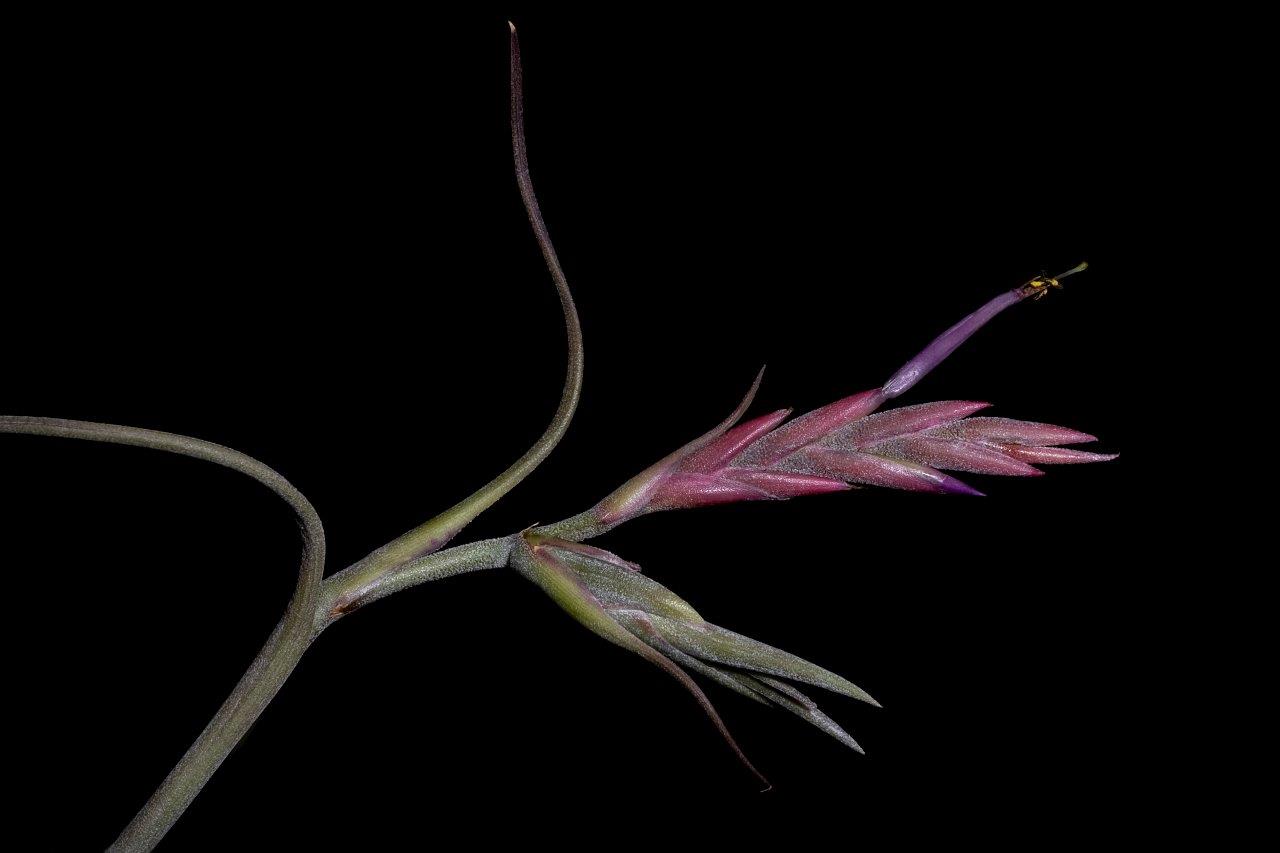
"Mez described in 1898 a plant collected near Cihuatanejo by Langlasse No.370 as TilIandsia intermedia. The isotype is in the Humboldt Herbarium in Berlin. It is distinguished from T. paucifolia Baker by
(1) Coming from the Pacific coast of Mexico between Zihuatanejo and Puerto Vallarta.
(2) The different habit in that it is a narrow plant with long mostly twisted, not sharp leaf blades, a very long flower stem & different spike. The plant is very variable with a reported giant form from Maruata to 60cm long and 140cm long when flowering. Whilst there is viviparous offsetting there is also basal offsetting and can completely cover a bush or even a tree. Other plants can be scarcely 5cm long.
The Ehlers have made numerous journeys into these special areas and have not been able to find any distinguishable differences amongst the various young plants. The feature of viviparous growth (such as in T. baileyi, T. stricta, T. cacticola, T. argentea) can hardly be used to split into a subspecies or a variety. The isotype deposited in Berlin shows that the viviparous growth emerges from the lower half of the inflorescence. The result is that T. intermedia Mez is a good species rather than being a synonym of T. paucifolia Baker. T. paucifolia subs. schubertii F.Ebel and Roeth in Flora pages 179-187, Halle 1988 is considered a synonym of T. intermedia Mez. The classification of the plants ranging from Florida to Cuba need further wide study."
You should be able to find Puerto Vallarta quite easily on any Mexican map but Maruata is a bit more difficult. It is found at 18º.16N, 103º.20W.
The cultivar 'Dimmitt's Delight' is clearly T. intermedia and probably does not need this cultivar name now that it is NOT a T. paucifolia! Paul Isley does mention in his book 'Tillandsia' that this plant comes from Mexico and if what Renate Ehlers says is true must come from the Pacific coast.
T. paucifolia var. prolifera is a plant given this name by the U.S. nursery trade and has no botanical standing but this too must be considered as being another T. intermedia Mez. If you are aware of any collections of this T. intermedia Mez NOT on the Pacific coast of Mexico please let me know and I will advise Renate Ehlers.
Tillandsia paucifolia and others by K & R Ehlers in Die Bromelie 1991(2):46-49. 1991
In March 1981 we traveled with our friends Gerti Haugg and Gunter Noller to this area. On the way between Colima and the coast, we discovered the long forgotten T. diguetii Mez et Roland Gosselin, that had been reported before in Die Bromelie 1/1982. We drove over the Badeort Cuyutlan on the coastal road to the south. Near to Ortega, we saw from the road in the forest, large grasslike, red bushes shining below. Our cactus friends’ however, were keen to find Mammillaria beiseli, but we wanted to pick up a piece of Tillandsia on the way back. To find M. beiseli proved easier than we had expected, it was growing in the gravel by the road, we explored in between times, and were able to get over the pass via a reconstruction-route. The world ended in Maruata! A small airport had been built there, and one of the beautiful bays on the whole route invited us to rest. To our surprise, we found on a rock above the water a beautiful, group-forming Mammillaria and a Melocactus. On a large candelabra-cactus, only some metres from the beach, there was a large group of oversized Tillandsia intermedia to admire. This is the reason why we make the following comments.
Tillandsia intermedia Mez, 1903
Mez described a 1898 collected plant of Langlasse No. 370 near Cihuatanejo, whose Isotype is deposited in the herbarium of the Humbold University in Berlin. It differs from T. paucifolia Baker through the delimited area on the Pacific coast, through the differing habit, narrow plants with long, usually bent, not pungent leaf-blades, a very long scape and different spike. The plant is very variable, the aforementioned giant-form from Maruata, is the one extreme, and only 5 cm large plants at the other. The plant has a very large spread along the whole Pacific coast in Mexico between Zihuatanejo and Puerto Vallarta. We has often studied this type on our numerous trips into this area and also the different offsetting of which little is known. This characteristic of viviparous growth (like that with T. baileyi, T. stricta, T. cacticola, T. argentea, and others) is by itself probably hardly warranted subspecies or varietal status. The Isotype deposited in Berlin shows new growth from which the viviparous growth develops in the upper area below the inflorescence. The result is: Tillandsia intermedia Mez is a good species in its own right, whose association as a synonym to T. paucifolia BAKER is not justified. T. paucifolia subspec. schubertii F. Ebel et Roeth in FLORA, P., 179-187, Halle, 1988, is also considered a synonym to Tillandsia intermedia Mez. - The classification of the plants occurring in Florida and Cuba needs even further study.
Tillandsia intermedia of the type from Maruata makes large thickets, where single plants were large, up to 60 cm, flowering up to 140 cm.
Although T. intermedia usually forms offsets below the inflorescence, therefore viviparous, and so whole tree or bush is covered over with a curtain, the large form from Maruata only produces basal offsets.
Detail from McVaugh in Flora Novo Galiciana 1989
Tillandsia paucifolia Baker, Gard. Chron. II. 10: 748. 1878.
Tillandsia intermedia Mez, Bull. Herb. Boiss. II. 3: 141. 1903.
Tillandsia circinnata of most authors, not T. circinnata Schlecht.,1845. Fig. 9.
On trees and bushes, including mangroves, near the Pacific coast, mostly not far above sea-level, often hanging from trees by the coiled leaves, or the inflorescence proliferating repeatedly as a new rosette, forming a chain of plants.
Sin., Nay., Jal., Col., Mich., Gro.(Zihuatanejo, Langlasse 370, US!, an iso¬type of T. intermedia), Oax, Pue.,. Ver., Yuc., Chis.; Gentr. Amer.; W. Ind.; s Fla.; n S: Amer. The holotype (at K) was a cultivated plant of unknown origin.
San Blas (Ferris 5342, DS, cited by Smith, not seen; Gardner 1336!); between Tomatlan and Puentecillos (Hernandez s.n., ENCB, cited by Magana, not seen); region of Chamela (McVaugh 25215; many collectors); Manzanita: (Matuda 38381, MEXU, reported by Magana, not seen); w end of Bahia de Santiago (McVaugh 15887); Manzanillo (Eyerdam & Beetle 8701, Ferris 6205); Mpio: Aquila, San Juan de Lima (Puga 8611, IBUG).
Acaulescent, but often apparently elongated because of proliferation of the inflorescence (see above); leaves 5-8, thick, covered throughout with coarse pale scales; sheaths large, broadly ovate, inflated and forming a narrowly ovoid or ellipsoid pseudobulb 5-15 cm long, the inner sheaths merging gradually into the blades, closely enfolding the base of the peduncle, the outer ones much reduced and bladeless; blades involute-subulate, pungent, up to 20 cm long but often much shorter, 3-7 mm in diameter, curved or contorted or coiled; inflorescence erect, simple or digitately or pinnately compound, the few spikes erect or nearly so, linear lanceolate, acute, 2-10-flowered, up to ca 12 cm long, commonly much shorter; bracts of the scape (peduncle) imbricated; foliaceous with spreading or coiling blades up to ca 20 cm long; primary bracts similar, their blades shorter than or sometimes surpassing the axillary spikes; floral bracts erect, imbricated, elliptic, acute, not or scarcely keeled, 1.5-2.3 cm long, 2-3 times as long as the internodes of the rachis, exceeding the sepals, thin, nerved, pink-margined; densely lepidote; flowers sessile; sepals lance-oblong, acute, 1.5-2 cm long, thin, glabrous, weakly nerved, the adaxial (posterior) pair more or less connate; petals linear, tubular-erect, 3--4 cm long, violet or "amethyst" (G); stamens and pistil exserted; stigma spiral; fruit slenderly cylindric, 3-4 cm long, 3-4 mm in diameter; seeds ca 100; 2.5-3 cm long.
Sometimes confused with Tillandsia caput-medusae, in which the leaf-blades are sometimes coiled and contorted as they commonly are in T. paucifolia. The two are usually well separated by the differences in the floral bracts, which in T. caput-medusae are glabrous or essentially so.
The name Tillandsia circinnata, as applied to this plant, became well known to botanists and plant-growers, presumably because of the curiously distinctive habit of the plant. In 1982, however, Wilhelm Weber pointed out, after study of the type specimens at HAL, including both flowering and fruiting plants, that the name T. circinnata was originally applied by Schlechtendal (Linnaea 18: 430. 1845) to a very different species, a native of the Caribbean lowlands (Weber, W. Herbarium Studies III. J. Bromel. Soc. 32: 28-31.1982).